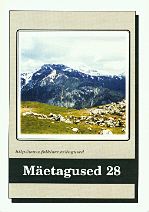Maastik vinguva jalaluuga. Ühest muistendist Friedrich Reinhold Kreutzwaldi muinasjuturaamatus
Landscape with a whining shinbone. On a legend in the folk tale anthology by Friedrich Reinhold Kreutzwald
Author(s): Mare KaldaSubject(s): Customs / Folklore
Published by: Eesti Kirjandusmuuseum
Summary/Abstract: In 1866, as a result of the work of the famous Estonian epic compiler Fr. R. Kreutzwald, a copious collection of Estonian folk tales was published in Helsinki. New editions of the anthology have been published later. Among other tales the book contains 18 legends, thus posing a question of the future (and reception) of the legends in such a prestigious anthology, and the role of knowledge about legends in this culture area. The article focuses on a legend entitled A Whining Shinbone (Vinguv jalaluu, in Estonian), but also touches upon more general issues and models of analysis in legend research. The emphasis on these aspects relies on Lauri Honko's studies on dense text corpora and textualisation strategies, and the discussions of theoreticians of intertextuality on manifestations of intertextual links. The legend discussed in the article narrates about a corpse left unburied in a valley in the course of tumultuous war a long time ago, and how it began whining at nights to attract attention until a brave man gave it a proper Christian burial and the soul of the deceased found its peace. In return, the brave man found a huge fortune. A comparison of the printed text with oral accounts and recollections held in the Estonian Folklore Archives revealed that the text corpus is formed of both published legends and also those recorded from oral presentations; the intertextual links become evident also relying on the relatively fragmentary text corpus; the recorded variants of the legend display various details, which attest of the materialisation of the freedom in storytelling, and also fixed motifs, which are suggestive of the responsibility of a storyteller in mediating the lore (using as little variation as possible); the recorded variants of the legend include motifs which enable to draw parallels between the texts and printed sources; regardless of the importance of the printed legend text, it is possible to differentiate between information dependent and independent of the printed anthology in this culture area; the setting of the legend is narrated into specific landscape. Chronologically, in the model of variant association of the legend of the whining shinbone it is possible to distinguish between five types of links: (i) published legends in new editions; (ii) links between a published legend and oral accounts directly influenced by it; (iii) links, in case of which the orally circulated legend has been preceded by accounts directly influenced by book legend; (iv) information considering the existence of the book legend, but different from the latter (parallel link to the book); (v) links of assumed instances of performance, which include the four previous possibilities.
Journal: Mäetagused. Hüperajakiri
- Issue Year: 2005
- Issue No: 28
- Page Range: 99-122
- Page Count: 24
- Language: Estonian

